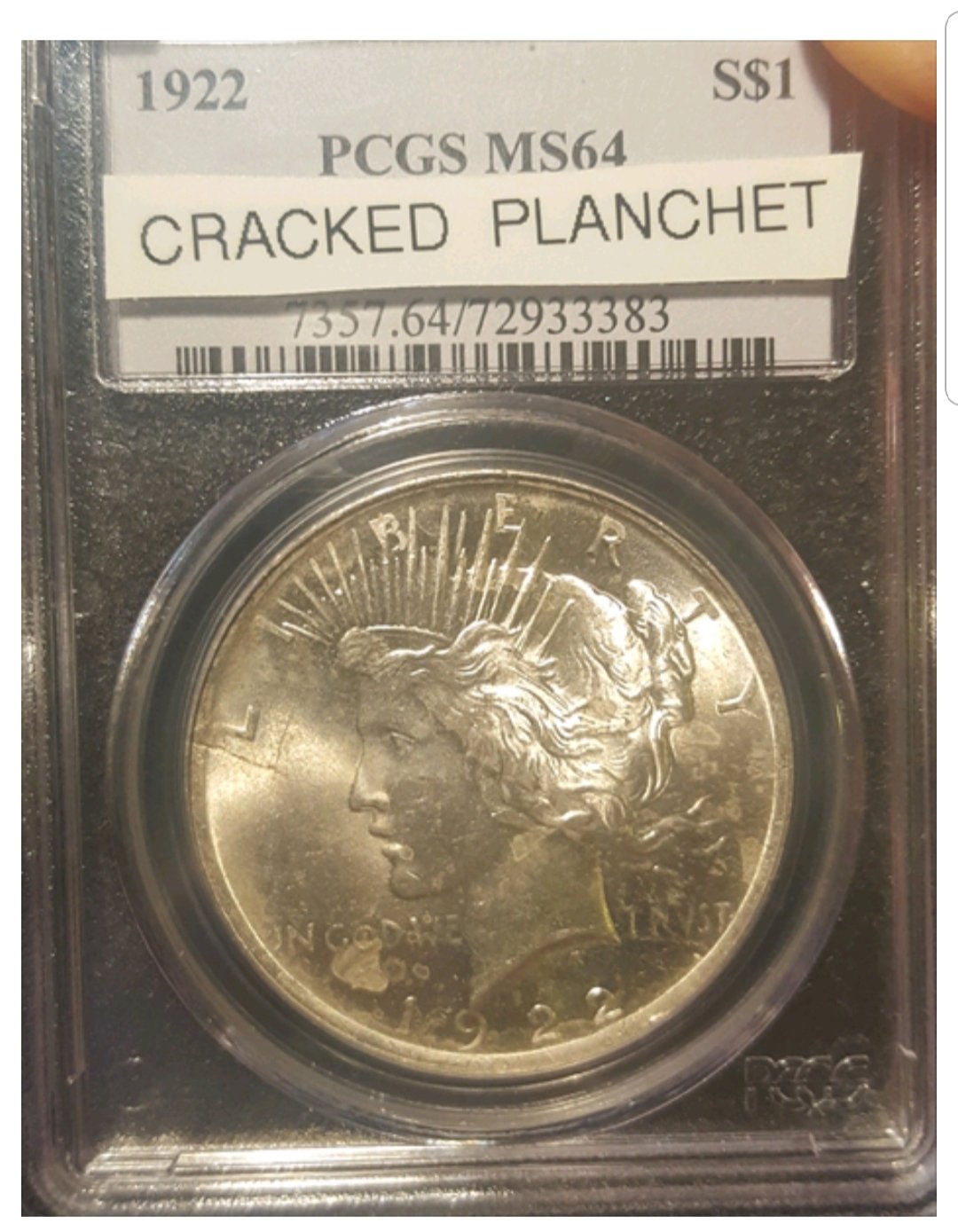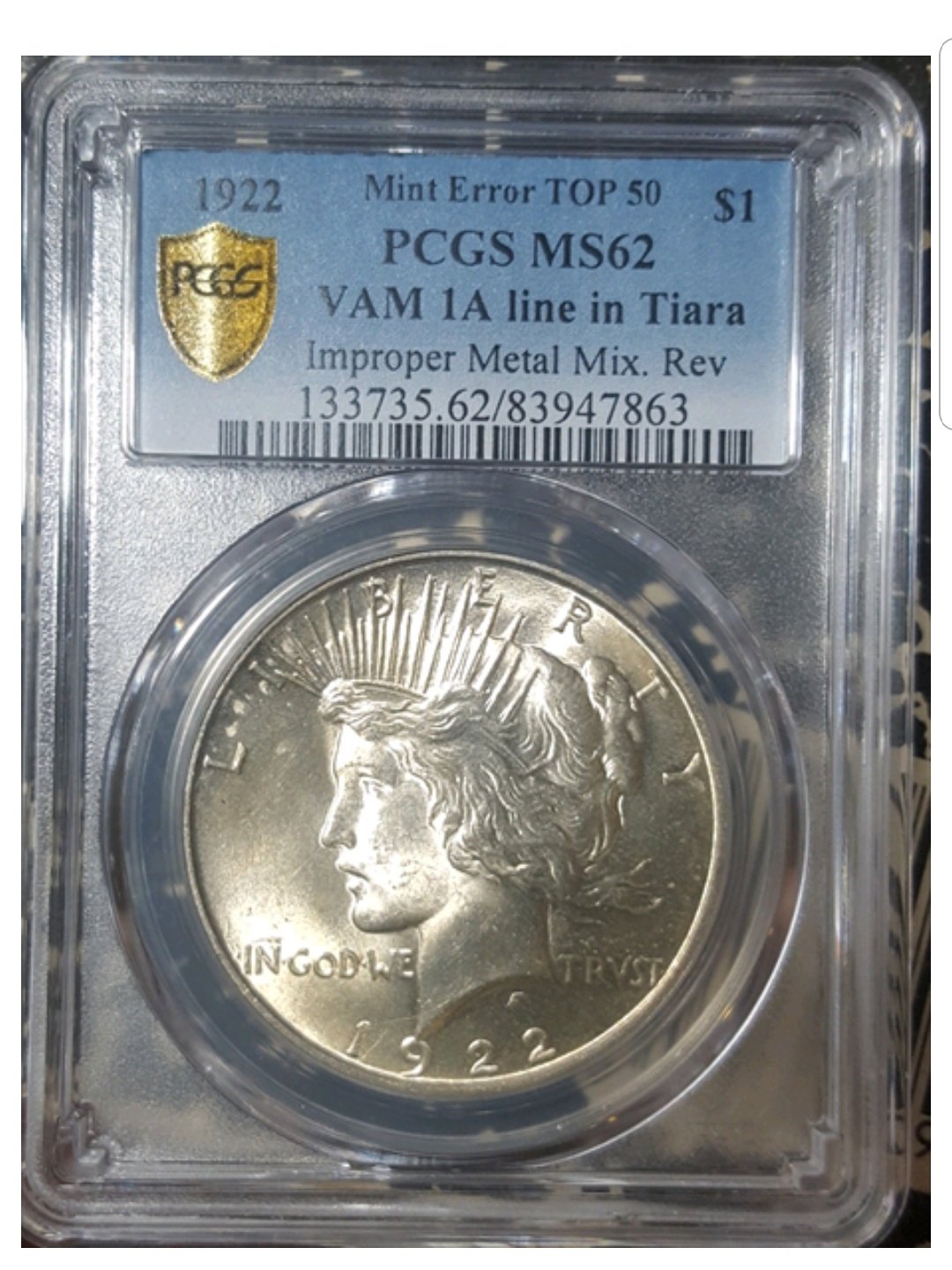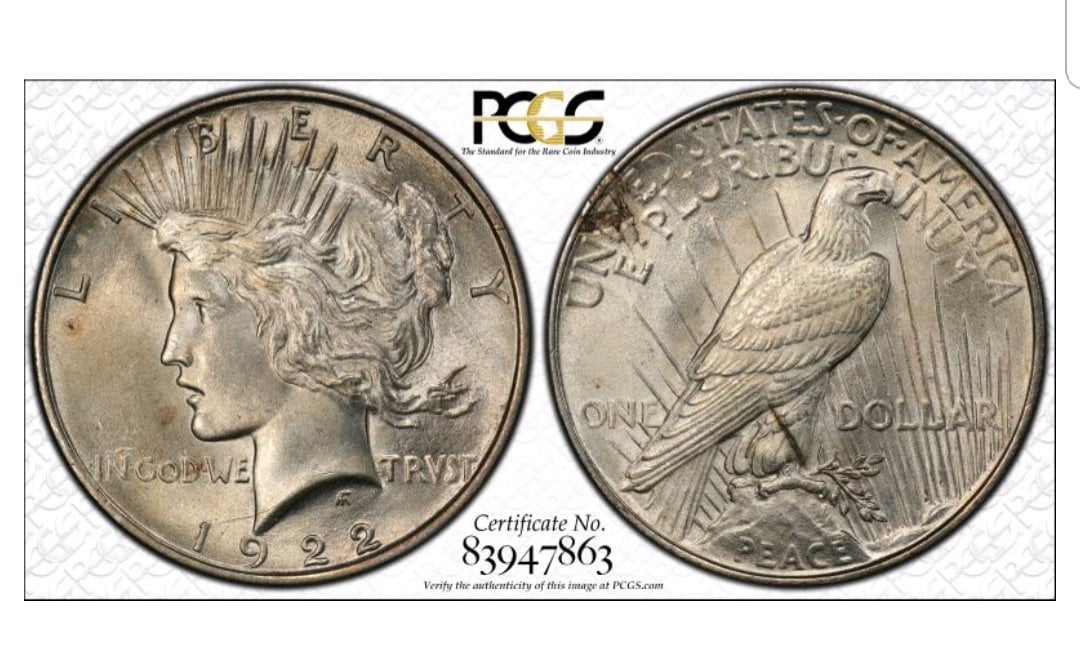Genuine grades for planchet flaws?
One of my PCGS submissions was put in a "genuine" holder with the notation "planchet flaw." Code 93.
Why does a planchet flaw result in a "genuine" designation? Planchet flaws are as minted. I can understand why a planchet flaw should be described as it lowers the value, but don't understand why it doesn't get a regular grade.
1
Comments
You need to pay a little extra for error designation.
I think they consider it a mint made error and if that is only 'problem', would get a grade with error submission. Nickels seem the worst for planchet problems.
I don't want an error designation.
It's inconsistent that with an error designation the coin would not get a genuine holder. The amount you pay for grading shouldn't determine whether the coin gets graded.
http://www.shieldnickels.net
My guess is the "sight unseen" rule ??
My Saint Set
FWIW
Planchet Flaw
Metal impurity or defect in the planchet. Small, unobtrusive planchet flaws are acceptable. Large, obvious, poorly placed, or distracting flaws are rejected. Context is also important. Planchet flaws on certain U.S. Colonial coins are expected; planchet flaws on Morgan Silver Dollars are not.
https://www.pcgs.com/grades/
My opinion is that planchet flaws are defects rather than striking "errors". They should not be in graded holders.
Our host straight grades chop marked Trade dollars which occurred post mintage. It seems inconsistent that they do not straight grade planchet flaws which occurred during the minting process.
Why is the size and location of the metal impurity or defect in the planchet used to determine if a coin straight or details grade?
If your market grading, then the size and location of the planchet flaw can effect a coins value. I agree that planchet flaws are defects rather than striking errors but so are chop marks.
Planchet flaws should be straight graded and described just like chop marked Trade dollars. I realize that some chop marked Trade dollars are not straight graded because of excessive damage. This standard could also be applied to coins with planchet flaws.
I agree that a manufacturing flaw as part of the minting process is an error and should be treated as such. Wonder how many MS and AU coins have been disregarded by TPG's. Great thought for the day. Peace Roy
BST: endeavor1967, synchr, kliao, Outhaul, Donttellthewife, U1Chicago, ajaan, mCarney1173, SurfinHi, MWallace, Sandman70gt, mustanggt, Pittstate03, Lazybones, Walkerguy21D, coinandcurrency242 , thebigeng, Collectorcoins, JimTyler, USMarine6, Elkevvo, Coll3ctor, Yorkshireman, CUKevin, ranshdow, CoinHunter4, bennybravo, Centsearcher, braddick, Windycity, ZoidMeister, mirabela, JJM, RichURich, Bullsitter, jmski52, LukeMarshall, coinsarefun, MichaelDixon, NickPatton, ProfLiz, Twobitcollector,Jesbroken oih82w8, DCW
I disagree with those who think that coins with significant planchet issues should be straight graded. Such problems lower the value of a "classic coin" sometimes significantly, especially if the piece in question qualifies for a high grade otherwise. It is not fair to buyers to have this issue sprung on them. Such coins should be designed as error coins, which allows buyers to take the problem into consideration.
One grading service straight grades chop-marked dollars, the other doesn't. One company straight grades "E" and "L" counter-marked coins the other doesn't. I don't know what the criteria should be but if a details grade kills the coin's value maybe there is a good middle ground solution with the end consumer in mind.
While planchet flaws can be interesting, they are still defective product, and, if not preserved, will often degrade further. True, a planchet flawed coin is 'as minted', but not considered an error. Minor planchet flaws have, in some cases, received grades. My impression is, that severity plays into the decision. I do not have supporting evidence of that statement.... just based on observation. Cheers, RickO
my understanding is that some coins with planchet flaws get the no grade designation because there is the possibility that the planchet flaw becomes separated from the coin. My experience is that if you send it in again, you might have a different result.
Sent this in first time for cross (from Newman/NGC/CAC 63) at any grade, result was no cross due to planchet flaw. Sent second time for cross at any grade, graded 61 (now CAC gold):
When a label states "Planchet Flaw" nothing is being "sprung on anybody." And please don't even play the "value card." TPGS DO NOT put a specific and reliable VALUE on a coin. Otherwise all 65's would be worth the same amount of money!
IMO, there is not any coin ever struck that cannot be graded (true technical grading - GRADE THE COIN, state both the problems or +/- attributes (such as "rainbow toning" or "flat strike"). Detail grading now done by the major TPGS is simply a return to this old system devised in 1973 for internal records at a Certification Service in DC.
Hopefully, the new group at PCGS will realize the inconsistency of not grading these coins.
We shall agree to disagree.
A major planchet flaw is major problem that lowers value for the classic coins that have them. This is not a theory on my part; it is based on personal experiences. Anybody who tells you that these problems do not lower the value of a coin is looking to sell you something. They are not buying it.
Then there is the inconsistency of putting SOME coins with planchet flaws in a GENUINE holder and other similar coins with planchet flaws get straight graded albeit likely knocked down by a gradepoint.
Essentially, yes. It depends on the specific flaw's appearance, and if it's so severe that a theoretical sight-unseen buyer would on average reject the coin at "the grade" that the otherwise detail and surfaces merit, it will get Genuined rather that quietly Netted down a bit.
Liberty: Parent of Science & Industry
The cracked planchet I purchased straight graded. The vam I purchased as an error and I sent in for variety attribution and had the E removed on the coin number to use it in the registry.



Disagreements are GOOD!
Yeah, let's drop the value (GRADE) because of a flaw. As soon as all the "NET" graders are either pushing up grass or realize that calling an AU coin VF because it is not worth AU money confuses those folks who are not aware of this "game" played by a small segment of the numismatic community much of the grading problem will b ended.
All we need to do is separate a coin's condition of preservation from its price! Then all the over-graded rarities can be returned to their actual grade while still costing millions. Then a blind dog will be able to grade an 1804 dollar and we'll all agree within a quarter of a point!
In the beginning, the major services did not want to slab flawed coins as it **would hurt the acceptability they wished to generate for their product. Now they slab corroded coins and it has not been a problem. IMHO, if a TPGS were to slab a polished coin with a label stating it was just "cleaned" would be a bigger disservice to the collector than slabbing a planchet defect and identifying it!
I have confidence that the OP will be satisfied in the long run.
It's genuine. That's good enough for me (to discount it)
``https://ebay.us/m/KxolR5
Bravo! Very well said Insider2.
Here's the coin that prompted my question:
http://www.shieldnickels.net
Personally, I don't feel like net grading is all that difficult to understand, it just hasn’t been utilized as much as other grading methods. Basically, you identify a sharpness grade (derived from the standards set forth for each grade)and then reduce that number based on the severity of defect(s). There are also qualifiers that identify surface quality, which can be helpful when you’re not able to see the coin in hand. One of the things I like about net grading is that problem coins are still going to get a number, albeit one that accounts for a coins issues. It's a system that makes sense to those that subscribe to it. Net grading is certainly a different way of evaluating a coin, but the TPGs have different standards for their slab grades as well.
I will admit that I tend to have two numbers in my head when I look at a coin. One of them is what I think it would slab (even though I tend to like my coins raw), and another that evaluates the coin using net grading. Then I simply code switch based on who I’m interacting with when discussing the coin.
In regard to the original question about planchet flaws, I hate seeing a coin in a details slab based on an issue coming out of the mint. Unless the issue is severe, I’d like to see the coin get a number, even if “planchet flaw” makes it on the label.
Exactly what I would have liked on the subject coin.
http://www.shieldnickels.net
not many FS-103s graded, that one is definitely one of the best, but won't even make population report
Net grading will never work with state colonial coppers. Certain issues always come with some sort of as made planchet problems due to the poor quality copper used to make the coins. The questions then are, how bad are the flaws, how many flaws, where are they located, etc. In addition, outside of the flaws, how choice are the surfaces? I have seen coins at all ends of the spectrum. That’s up to me to make the final decision.
Years ago I had a very nice Mint State Shield Nickel on consignment from a client. The technical grade was MS-65, but it had large and still attached lamination on the obverse. It was in a SEGS holder because at that time it would have gone into a body bag if it had been submitted to either of the major services. I really liked the coin from the historical perspective because it showed how the Philadelphia Mint had problems producing those pieces from "the devil's copper."
The coin was priced to me at $100 under the Gray Sheet MS-65 price at the time, but I couldn't even get a bite on it. No one would have me take it out of the case to look at it. I gave it back to the customer after a couple month's worth of shows.
What was the market price for the piece? I don't really know, but my guess would have been somewhere in the MS-60 to 63 range if you could find a customer who liked it from the hsitorical perspective as I did.
This 1793 half cent was in Roger Cohen's collection and was sold in the auction of his collection. As described it had a technical grade of EF, which would probably be AU-50 or more today, but it had this big lamination. The coin sold for $2,750 in 1992. Other 1793 Half Cents in the same sale, that were in lower technical grades, sold at prices ranging from $8,525 to $3,740.
During a similar period, I was paying like money for this piece in VF (NGC over graded it at VF-35) with smooth, brown surfaces, but rim issues.
My point is that mint caused issues, like large laminations, do effect the value of a coin, especially an older coin.
Planchet flaws are errors as they come from the mint. Chopped Trade Dollars are Post Mint Damage and are in a completely different category. Their popularity is why the TPG's finally began assigning straight grades chopmarked.
whatever a TPG writes on the label should be mostly irrelevant to a knowledgeable buyer.
hence the question: why should TPG's make us aware of issues what they think are issues?
the coin was submitted for grading , and NOT for a price evaluation either. Any reduction or increase in Value because of "whatever issue" should be exclusively up to the buyer when examining the item.
This subject could go on for a long time. However until we have a solid norm or official guideline for grading, and or one for evaluating, we will have these issues for a long time to come.
Buy coin in hand!!
If your criteria of what you would like is met, agree on a price and done. flaws or no flaws.
Here is an example of a pretty nice coin with a planchet flaw. The reverse is as good a strike as I have seen.
I stretch to see the reasoning for buying other than straight graded coins unless the collector is a specialist and the item is not available in straight grade slab.
That's just me though.
But "Genuine" or "Details" will shut me down immediately in a search.
Oh wait. I forgot someone submitting a coin for the first time.. Sorry.
In accurate and consistent grading, any presumed value of the piece is immaterial.
If a planchet was defective when struck, the resulting coin remains subject to the same degrading forces as a normal coin. However, the defect must be mentioned since it is an anomaly.
A chop marked coin is unrelated to a planchet defect. The chop is a post-production mutilation identical in nature to punched advertising or a hammer blow. Distinctions are made only because some marks are intelligible and others are not.
@Colonialcoin said: "Net grading will never work with state colonial coppers. Certain issues always come with some sort of as made planchet problems due to the poor quality copper used to make the coins. The questions then are, how bad are the flaws, how many flaws, where are they located, etc. In addition, outside of the flaws, how choice are the surfaces? I have seen coins at all ends of the spectrum. That’s up to me to make the final decision.
You are correct. What you purchase is entirely up to you. However, you may wish to tell the other "copper guys" that they should stop net grading colonials!
@BillJones said: "Years ago I had a very nice Mint State Shield Nickel on consignment from a client. The technical grade was MS-65, but it had large and still attached lamination on the obverse. It was in a SEGS holder because at that time it would have gone into a body bag if it had been submitted to either of the major services. I really liked the coin from the historical perspective because it showed how the Philadelphia Mint had problems producing those pieces from "the devil's copper.
The coin was priced to me at $100 under the Gray Sheet MS-65 price at the time, but I couldn't even get a bite on it. No one would have me take it out of the case to look at it. I gave it back to the customer after a couple month's worth of shows. What was the market price for the piece? I don't really know, but my guess would have been somewhere in the MS-60 to 63 range if you could find a customer who liked it from the hsitorical perspective as I did."
As you posted, every coin has a price. I guess the price of the laminated coin was not low enough. Many consider these mint-made imperfections as damage and unattractive. I cannot argue with that opinion. I do know that a larger percentage of business at some TPGS consists of these unattractive pieces. That 1912-S is a perfect example.
Both of those nickels are problem coins to a type set collector, but they'd be right at home in a collection of error coin or nickel specialists. Uncirculated detail, planchet flaw seems appropriate, how can one assign a number?
Liberty: Parent of Science & Industry
Defects can also can come from the mint. "Planchet flaws are errors as they come from the mint."
I said "Our host straight grades chop marked Trade dollars which occurred post mintage."
Sounds almost the same as what you said. "Chopped Trade Dollars are Post Mint Damage"
I agree with this. "Their popularity is why the TPG's finally began assigning straight grades chopmarked."
What I think is most important is " the defect must be mentioned since it is an anomaly."